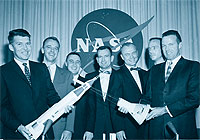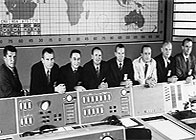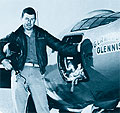(Malcolm) Scott Carpenter (1925– ): Carpenter, the only child of Marion and Florence, grew up in Boulder, Colo. After earning a bachelor of science in aeronautical engineering from the University of Colorado in 1949, Carpenter joined the Navy and served in the Korean War. As one of the Mercury 7, Carpenter flew the second American manned orbital flight on May 24, 1962, completing three revolutions of the earth. Upon retirement from the Navy in 1969, after 25 years of service, Carpenter founded and was chief executive officer of Sear Sciences, Inc., a venture capital corporation active in developing programs aimed at enhanced utilization of ocean resources and improved health of the planet. He has dived in most of the world’s oceans, including the Arctic under ice. Commander Carpenter has been married three times and has seven children. He has authored two novels and a personal memoir, For Spacious Skies: The Uncommon Journey of a Mercury Astronaut.
(Leroy) Gordon Cooper (1927–2004): Cooper, the only child of Leroy and Hattie, grew up in Shawnee, Okla. He joined the United States Marine Corps while still in high school, and after graduating was briefly called to active duty in 1945. He served a short time at the end of World War II, then enrolled at the University of Hawaii and enlisted in the U.S. Army Air Corps. Cooper met Trudy Olson, a licensed pilot, and the two married in 1947. Together, they had two daughters, Camala and Janita. Cooper earned his degree in aeronautical engineering from the Air Force Institute of Technology in 1956. On May 15-16, 1963, he piloted the “Faith 7” spacecraft on a 22-orbit mission that concluded the operational phase of Project Mercury. He retired from the Air Force and NASA in 1970 after logging 222 hours in space, serving as backup command pilot for Gemini 12 and as backup commander for Apollo X. In his post-NASA career he served on many boards and consulted on technical projects for various corporations. After his first marriage ended in divorce, Cooper married Suzan Taylor and had two more daughters, Elizabeth and Colleen. Cooper died of natural causes on October 4, 2004.
John Glenn (1921– ): Glenn was born in Cambridge, Ohio and graduated from high school in 1939. He married his high school sweetheart, Anna “Annie” Castor, in 1943 and they later had two children, John and Carolyn. He attended Muskingham College and earned a bachelor of science in engineering. During World War II, Glenn flew 59 combat missions and in the Korean War flew 63. As part for the Mercury 7, Glenn was the first to orbit the earth on February 20, 1962. Glenn served as a U.S. senator from Ohio from 1974–1999. In 1998, NASA invited him to join the Space Shuttle Discovery Crew and he became the oldest human to venture into space. Glenn and Annie founded the John Glenn Institute for Public Service at Ohio State University and he is the recent recipient of the Theodore Roosevelt Award for 2008.
Virgil “Gus” Grissom (1926–1967): Grissom, the oldest of Dennis and Cecile’s four children, was born in Mitchell, Ind. In high school, he enlisted in the U.S. Army Air Corps when World War II began, and reported for duty in 1944 after graduation. He met Betty Moore and they married in 1945. Together they had two sons, Scott and Mark. He graduated from Purdue University in 1950 with a bachelor of science in mechanical engineering. During the Korean War, he flew 100 combat missions and later served as a flight instructor. He piloted the second and final suborbital Mercury test flight on July 21, 1961. In 1965, Grissom served as command pilot on the first manned Gemini flight, and served as backup command pilot for Gemini 6. Grissom and two fellow astronauts, Ed White and Roger Chaffe, were tragically killed on January 27, 1967 when a fire started aboard the Apollo spacecraft during a training exercise.
Walter “Wally” Schirra (1923–2007): Schirra grew up in a family of aviation devotees. His father was a U.S. military pilot during World War I who later became a stunt pilot and his mother was a “wing walker.” Schirra had his pilot’s license by the time he entered the Newark College of Engineering and enlisted in the naval officer’s training program when World War II broke out. He completed 90 combat missions during the Korean War and then served as a test pilot for the U.S. Navy. Schirra married Josephine Fraser and had two children, Walter III and Suzanne. On October 3, 1962, he piloted the six-orbit Sigma 7 Mercury flight. In 1968, Schirra sent the first televised pictures of Earth from space from aboard Apollo 7. Schirra retired from NASA in 1969 and later co-authored the book The Real Space Cowboys with Ed Buckbee. Schirra died of a heart attack on May 3, 2007.
Alan Shepard (1923–1998): Shepard grew up on a farm in East Derry, N.H. with his parents, Alan and Renza. In 1944, he graduated from the United States Naval Academy with a bachelor of science. In 1945, he married Louise Brewer and they had three children: Julie, Lauren and Alice. During World War II, he served in the Pacific and later became a test pilot. On May 5, 1961, Rear Admiral Shepard was the first of the Mercury 7, and therefore the first-ever American, to enter space. After Project Mercury, he became the fifth man to walk on the moon with the Apollo 14 mission. Shepard retired from NASA in 1974. He was diagnosed with leukemia in 1996 and died from complications on July 22, 1998.
Donald “Deke” Slayton (1924–1993): Slayton, the oldest of five siblings, grew up near Sparta, Wis. He graduated high school in 1942 and immediately enlisted in the U.S. Army Air Corps. Slayton completed 56 missions over Europe and seven over Japan during World War II. In 1949, he graduated from the University of Minnesota with a bachelor of science in aeronautical engineering and became an engineer for the Boeing Aircraft Company. In 1951, Slayton applied to be a captain in the U.S. Air Force during the Korean War, and from 1952 to 1955 he served as a fighter-squadron pilot and wing-maintenance officer at posts in California and Germany. There he met Marjorie Lunney and the two married on May 15, 1955, later welcoming their only son, Kent. As part of Project Mercury, Slayton was unable to complete a mission due to a heart condition discovered in August 1959. After serving as director of Flight Crew Operations with NASA, Slayton was again certified eligible for manned space flights in March 1972 and made his first space flight with the Apollo-Soyuz Test Project (ASTP) mission in July 1975. Slayton retired from NASA in 1982 and died in 1993 from brain cancer.
Chuck Yeager (1923– ): Yeager was born in Myra, W.Va. to Albert and Susie. He enlisted in the U.S. Army Air Corps in 1941 at the age of 18 and flew 64 missions during World War II. In 1945, he married Glennis Faye Dickhouse and they had four children. Yeager was the first man to break the sound barrier on October 14, 1947, flying the experimental Bell X-1 at an altitude of 45,000. In 1969, Yeager was promoted to brigadier general and has earned numerous merit awards. Yeager officially retired from the Air Force in 1975 and has written two autobiographies.
Content last updated: October 31, 2008




